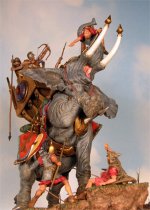Given the current popularity of Roman figures, Barbarian figures are important in battle scenes and dioramas. The Romans beat the Carthaginians, Etruscans, Macedonians, Selucids, Ptolomys, Celts ( Celt-Iberians, Gauls, Britons, Dacians) etc. The Germans were never beaten as a people; they sacked Rome and ultimately defeated and occupied the Western Roman Empire. The Germans were the ultimate Roman adversary. The Teutoberg battle and the loss of three legions was the start of the ultimate Roman defeat by the Germans over a period of over 400 years and many interesting battles. Domitian fought the Dacians and lost two Legions. Marcus Aurelius fought the Marcomanni for 15 years and the many battles ended in a draw. The Emperor Deceius was the first Roman Emperor to die in battle. He and his Legions were destroyed by the Goths in 250 AD. The Eastern Roman Emperor Valens and 8 of 10 Legions were destroyed by the Visigoths in 378 AD.
A lot of great potential dioramas if sufficient barbarian figures are available.
Conte, King and Country, Thomas Gunn and First Legion have all done excellent Barbarian figures;
of both Germans and Celts. The question is; who has made the best Barbarian figures to date?
I personally like the Conte figures: Behold the Power of Rome SPQR 015. The scene is dramatic and very well done IMO. The King and Country Barbarians are excellent figures. The Celtic Chieftain was exceptional IMO. W. Britains Saxon figures are a reasonable representation of a 3rd or 4th Century Goth or Visigoth.
A lot of great potential dioramas if sufficient barbarian figures are available.
Conte, King and Country, Thomas Gunn and First Legion have all done excellent Barbarian figures;
of both Germans and Celts. The question is; who has made the best Barbarian figures to date?
I personally like the Conte figures: Behold the Power of Rome SPQR 015. The scene is dramatic and very well done IMO. The King and Country Barbarians are excellent figures. The Celtic Chieftain was exceptional IMO. W. Britains Saxon figures are a reasonable representation of a 3rd or 4th Century Goth or Visigoth.


